Holiday in Cambodia ('natch) - Part 2
MARCH 21
SIEM REAP TO PHNOM PENH
A pickup truck fetched us at 5:30 a.m. It was going to take us to the port, where we were to catch a speedboat to Phnom Penh.
After a half-hour of driving in circles picking up other tourists, our truck blew a tire. Everyone got out and stood around. Some people started to walk, no apparent destination in mind. Finally, a minibus pulled up. We all piled in for the bumpy forty-minute drive.
For once, we were up early enough to watch the monks asking for alms. Clad in their orange bedsheets, they walked from house to house, collecting rice in small tins they held by their bellies. It would've been more scenic if we weren't all worried about missing the speedboat.
Finally, we reached the pier, where we had to walk through a maze of mud and food stalls, to a small motorboat. The speedboat was actually anchored out in the harbor, and the motorboat was to take us to it.
Port of Siem Reap
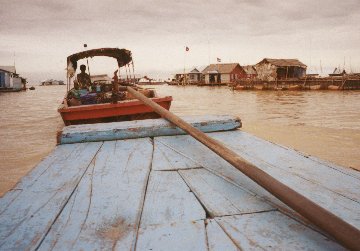

Except the motorboat couldn't take us anywhere, because its battery was dead. Our boat driver yelled to a friend, and performed a complex maritime procedure involved swapping heavy batteries over ten feet of filthy water.
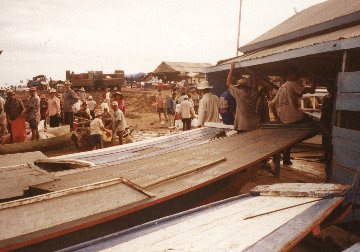
Finally, again. We were off. We puttered through the makeshift town on stilts, built over the water. This time we made a lot of progress -- it was a good half hour before we stopped again.

The engine ground to a halt. We were out of gas. We looked ahead, straining to see "Rambo," the speedboat. We were a half an hour late. Would Rambo wait for us?
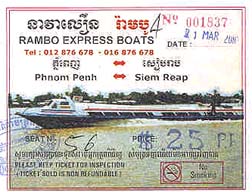
ticket for speedboat "Rambo"
Another boat gave us a tow and Rambo was still in port. We all piled on, getting the last seats right by the dieselly engine (yuck). Fiona went straight to the roof, where she learned that even her naturally dark skin is not immune to sunburn. Lynne and I tore into some chocolate cookies I'd brought along, and then I decided to have a look at the toilet.
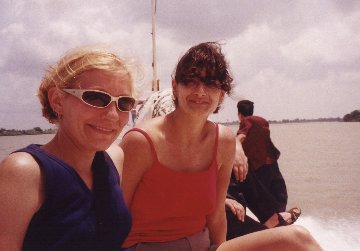
Marie, Fiona on "Rambo"
It was a squat toilet, with natural plumbing. The Tonle Sap river bubbled up into the bowl. Fair enough, I thought, but how am I supposed to climb up there? The toilet was about three feet off the floor, and there was no ladder. I wondered what women in skirts did. Never mind, I thought, and clambered successfully up the tiny walls.

The Rambo speedboat toilet, 3 feet high and rising
Half of Stuart's "Intrepid" group was along for the ride, but Stuart himself had taken the plane. Intrepid has added the "fly" option, presumably because people wanted to spend more time in Phnom Penh and less time inhaling diesel fumes and negotiating bizarre toilets.

Phnom Penh
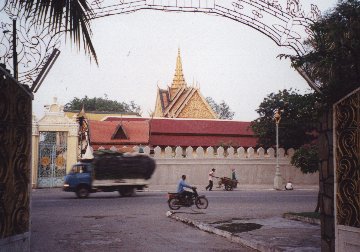
View from Phnom Penh's Renakse Hotel
I had booked a room ahead at the Renakse Hotel. The rooms are mediocre, but the hotel is located directly across the street from the Royal Palace. The view at night was spectacular. The Renakse had sent a driver to pick us up, so we were able to ignore the hordes of touts and moto drivers who didn't appear to understand the word "no."
|
Moto drivers in Phnom Penh are a peculiar bunch, who are occasionally fluent in English but they appear to have brain damage as they often have lapses, forgetting words they knew only moments before. Perhaps it is a contextual thing, as "no" within a sentence appears to be easily understood, but "no" said by itself never sinks in.
|
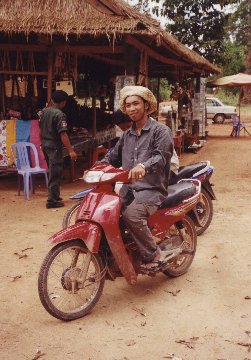
19-year-old demonstrates the "beanie" moto hat
|
Bayon-Pearnik, a monthly magazine out of Phnom Penh, published an extensive analysis of the moto driver's habits in its March issue.
"There are two main breeds of the species: Motodopius Cambodiata, the Lesser Baseball-Capped Motodopius and the Greater Beanie-Hatted Motodopius."
Pleased to have some insight into the ubiquitous moto driver, I read on.
"The correlation between hat type and behaviour is not yet clearly understood, but it is thought the development from a Baseball to a Beanie is symbolic of a great level of reasoning skills and a later stage of evolutionary advancement."
That made sense. The Beanies had wide brims on their hats, protecting them from the harsh sun.
"The friendly, communicative Motodopius unfortunately always loses comprehension of your language if you ask him for change of your dollar."
This I could vouch for.
"He attacks in groups, as stated previously, and whilst Motodopius is normally gentle by nature, when he becomes a member of the herd he is intensely competitive and aggressive. This herding characteristic enables him to cause great suffering to his prey. The common approach to the attack is to use the herd to completely overwhelm the prey, and then move in for the kill. Diversionary tactics are often employed, including loudly repeating the species name ("moto, moto") and much waving of the arms to confuse the prey.
"Motodopius could not survive in any other habitat. They have evolved to be perfectly adapted to the Cambodian environment. It is likely that they would be regarded as pests in most other countries and would be hunted to extinction by their main natural predator, Homo Sapiens."
I took time out to work on the website while Lynne and Fiona hired two Motodopius specimens to drive them to the Killing Fields. They were appalled by the 8700+ skulls all piled together as a monument, and by the scraps of clothing left by the mass graves where academics, doctors, and those unlucky enough to require eyeglasses had been bludgeoned to death. Pol Pot and the Khmer Rouge had been attempting to create an agricultural state made up of the common man, in which there was no room for intellect or class. In short, he wiped out all the competition, so that he would be the only brain in town. He was clearly insane, and he used impressionable youngsters to carry out a lot of his dirty work. He put the other kids into work camps, where they were trained in propaganda and agriculture. He got away with it because the rest of the world was unwilling to intervene in the post-Vietnam War era. Vietnam itself finally liberated/invaded Cambodia, and the Khmer Rouge took to the hills for many years.
Lynne and Fiona ran out of time, and missed the really grotesque site in Phnom Penh. The Tuol Sleng S-21 Museum is completely disgusting and horrific, with its torture chambers, splattered blood, and hundreds of photos of the doomed. Maybe it was my description that put them off.
We met up with Emma, an Australian traveling with Stuart's Intrepid group, for dinner at the upscale and airy Foreign Correspondent's Club. Emma taught us a new phrase -- "single-serving friends."
"A single-serving friend," explained Emma, "is one of those people you meet on the road. You exchange a few pieces of info -- how long you're on the road, where you've been, where you're going, what you do/did at home -- you hang out with them for a meal, or a day, and then you never see them again."
Intially, I was appalled. I had met Lynne on a trip to Central America, and I had met one of my closest friends, Nikki, on a trip through India and the Middle East. But I had to admit, she was right. For every Lynne or Nikki, I'd met hundreds of Emmas that I'd never see again.
MARCH 22
We left Cambodia on a minibus from the Capitol Guesthouse, for a ten-hour trip to Saigon. Lynne described the road as "more potholes than surface." A year ago, I had agreed that the road was terrible. Now, after my trip from Thailand, I regarded it as merely unpleasant.
Near the border, there was a stop to wait for a ferry. We were mobbed by little girls trying to sell bread, Coca-cola, water, and various forms of snack foods. One of them spotted me looking at my guidebook map. She was clearly interested, so I handed her the book. All of her friends crowded around, pointing and screaming the names of the countries.
"Cambo-DI-ah!" they screamed. "Vietnam! Thai-lan'!" They looked to me for assurances that I was impressed. I was, and nodded encouragement. They just about tore the guidebook to shreds in their excitement to look at its maps and photos -- I didn't mind. "Southeast Asia on a Shoestring" was out of date. It had served me well on my two trips to Asia, but was in need of retirement.
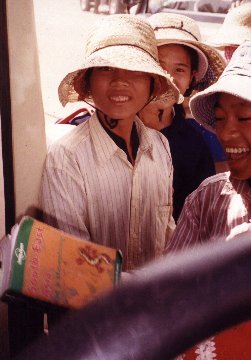
Kids look at guidebook
The bus started up and the girls panicked, desperate to get my book back to me before we left. They shoved it onto the minibus and backed off quickly, waving excitably as they neglected their jobs.
I got through the border quickly, brandishing my stamped health certificate when the officials tried to extricate more money from me. Fiona and Lynne had to pay the border bribe, and one official stole Fiona's yellow fever certificate before informing her that she was missing it and would have to pay the fine. One Japanese tourist tried to be clever, and requested a receipt.
"Okay," said the border guard. "$20 for a receipt."
The Japanese tourist went ahead and paid the $1 bribe.
The road to Ho Chi Minh City/Saigon was smooth and fast. We were there before dark.
NEXT: Sleeper trains, rice wine, and those weird marionettes that bob around in the water and spew fireworks. Vietnam, land of Uncle Ho!